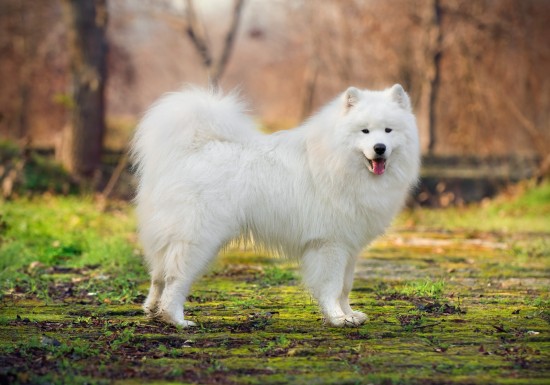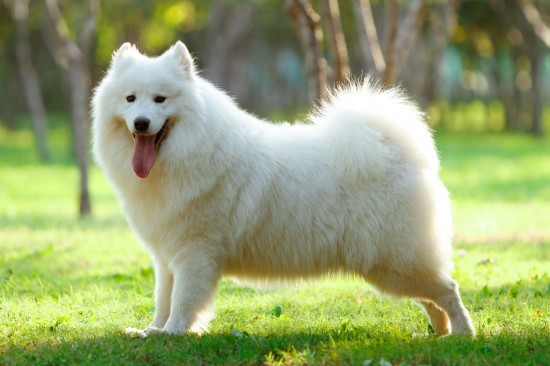





The Samoyed dog is a pure white and very fluffy dog that originated in Siberia in the frozen east of Russia. They were originally used by the nomadic people of the region as sled dogs, but today, have been widely distributed all over the world and are popular within the UK as pets and companions.
The Samoyed is a medium sized breed that can stand up to 22” tall at the withers, and weigh up to 25kg, with males of the breed being slightly larger than females. They belong to the spitz dog grouping, and have the typical spitz dog traits of pointed, upright ears, a curled tail, and a profuse and very thick coat.
Their coats are double layered, with a very dense undercoat to provide warmth, and a top layer of coarser guard hairs. Again, like most spitz dogs, they tend to shed their hair heavily all year round, and twice a year, will blow their coat for the new season, shedding all of their prolific undercoat in the space of just a couple of weeks. The Samoyed’s colour is white, with pure white being the most common colour, but it can also be found in a cream or biscuit shade too.
If you are wondering if the Samoyed dog is right for you, it is important to do plenty of research into the main traits of the breed, as well as finding out as much as possible about their general health, longevity, and if any health tests are advised for dogs of the breed. We will examine these factors in more detail within this article.
The average lifespan of the Samoyed is 12-13 years, which puts them towards the top of the average range across the board for all breeds of a similar size and build, and indicates a general propensity to good health.
The coefficient of inbreeding statistic for the Samoyed is 8.5%, which is higher than the 6.25% or less that is considered to be the ideal for pedigree dog breeds. This indicates that the Samoyed is subjected to a degree of inbreeding in order to keep their breed lines viable. Inbreeding is in some cases necessary to maintain the breed, but Samoyed breeders should reduce the coefficient of inbreeding statistic within their own breed lines where possible.
The build and proportions of the Samoyed dog are considered to be well balanced and fit for life, but the general breed standard can cause a couple of specific problems for the dog.
The British Veterinary Association and The Kennel Club make certain recommendations for health testing for different breeds of dog, in order to ultimately reduce the occurrence rate of known hereditary health problems within the breed. For the Samoyed dog, the following health schemes and tests are advised:
As well as the conditions listed above that are known to be hereditary and pose a particular risk to dogs of the breed, various other health conditions that are not covered as part of pre-breeding testing schemes have also been found to present within the Samoyed breed as well. The most common of these conditions are:
Copyright © 2005-2016 Pet Information All Rights Reserved
Contact us: www162date@outlook.com